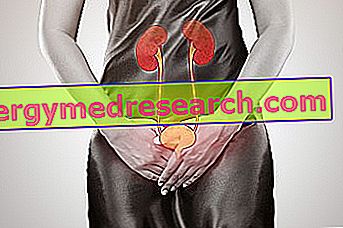Definition
Typically hereditary, hemochromatosis identifies a pathology in which iron accumulates exaggeratedly in the body's tissues: we are talking about a rather serious disease, given that iron, depositing itself in various organs, can cause serious damage, especially in the liver, cardiac, pancreatic and articular. Since it is often a genetically transmitted disease, haemocormatosis cannot be cured definitively, although some drugs and some diet-behavioral rules may reduce the symptoms.
Causes
It is estimated that the hereditary variant of hemochromatosis is the most frequent: the alteration of a gene involved in the regulation of the amount of iron absorbed with food is, in this case, the triggering cause. In other cases, the exaggerated accumulation of iron more be favored by pathologies, such as: sideroblastic anemia, alcoholic liver disease, abuse of vitamin C and iron with diet, thalassemia.
- Risk factors: male sex, age over 50 years
Normal dose of iron absorbed by a healthy individual: 1-2 g / day
Dose of iron absorbed in the case of hemochromatosis: 4-6 g / day → the iron deposits in the body reach even 20-30 grams
Symptoms
In the past, hemochromatosis was defined as "bronzy diabetes", referring to the bronze coloration assumed by the skin of an individual suffering from this pathology: the chromatic alteration of the skin is one of the first symptoms with which hemochromatosis begins; to this, other characteristic signs are added: joint pain, hepatomegaly, hypogonadism, drowsiness, fatigue.
- Complications: hepatic carcinoma, cirrhosis, diabetes mellitus, fibrosis
Information on Hemochromatosis - Drugs for the Treatment of Hemochromatosis is not intended to replace the direct relationship between health professional and patient. Always consult your doctor and / or specialist before taking Hemochromatosis - Hemochromatosis Drugs.
drugs
Hemochromatosis must be treated in time, even if, unfortunately, the disease is not always diagnosed early; the appearance of symptoms, as well as the intensity with which they appear, is rather gradual and is heavily influenced by the amount of excess iron absorbed by the body. According to these words, it is understandable how the removal of the iron surplus - before the hemochromatosis degenerates - is, to say the least, indispensable to escape the complications of the disease.
The treatment of choice, also in the genetic form of hemochromatosis, is therefore the removal of excess iron: this practice, called phlebotomy, consists in the regular extraction of blood (similar to blood donation), in order to restore the normal plasma iron level. It is not possible to report an approximate share of the amount of blood taken: this element depends on the age of the patient, the concentration of iron in the blood and the general health of the patient.
In the case of ascertained hemochromatosis, the patient must also be instructed on the correct dietary setting: to avoid, therefore, all foods in which iron is abundantly present, such as red meat, offal and shellfish. On the other hand, foods rich in fiber (wholemeal bread, whole wheat pasta, vegetables etc.) should be taken in abundant quantities in the context of hemochromatosis, since phytates and fiber decrease iron intestinal absorption. The consumption of alcohol is forbidden: compliance with this dietary rule is very important to curb the damage to the liver.
As for drugs, the administration of chelating substances is the most indicated: chelating substances promote the expulsion of iron from the body, through feces or urination. Chelation therapy is often associated with concomitant administration of ascorbic acid.
Long-term chelation therapy for the treatment of hemochromatosis
- Desferrioxamine (eg Desferal): very important chelating drug capable of complexing iron and favoring its expulsion towards the outside through urination. The drug is available as a powder and solvent for solution for injection; in most cases, therapy with Desferal should be started following 10-20 blood transfusions. The dosage must be carefully established by the doctor on the basis of the severity of the hemochromatosis, as well as the concentration of iron in the blood. It is also recommended to monitor the amount of iron excreted in the urine (after the dose of the drug) during the 24 hours following the administration of the drug. As an approximate value, it can be reported that the average daily drug dose is between 20 and 60 mg / kg; the drug is administered by subcutaneous infusion of 8-12 hours, 3-7 times weekly. Desferrioxamine is the drug of choice used in therapy for the treatment of hemochromatosis.
- Deferasirox (eg. Exjade): this is another chelating drug to be taken orally, not sold in our country. The drug, available in tablets to be dissolved in water or juice, is indicated for children older than 6 years and for adults suffering from hemochromatosis, forced to numerous blood transfusions. The drug is generally prescribed when desferrioxamine is not indicated for that patient. Indicatively, start therapy with an estimated dose of 10-30 mg / kg once a day (based on the concentration of ferritin in the blood and the amount of blood used during the transfusion); it is recommended to take the medicine on an empty stomach, at least 30 minutes before a meal, about always at the same time every day. The maintenance dose must be perfected in each individual case; in general, adjust the dosage of 5-10 mg / kg every 3-6 months. Do not exceed 30 mg / kg per day.
- Deferiprone (eg. Ferriprox): as an alternative to desferrioxamine (in patients with hemochromatosis who do not tolerate standard chelation therapy), it is recommended to take Deferiprone, a rather recent oral chelating drug, indicated for iron accumulation (especially for iron patients with thalassemia major). The drug is available as 500 mg tablets or as a 100 mg / ml oral solution. Indicatively, the dosage suggests taking 75-100 mg / kg of drug per day, in three equally divided doses. For the treatment of hemochromatiosis, do not exceed the dose of 100 mg / kg / day.
Supplementary therapy with vitamin C, to be associated with chelation therapy
- Vitamin C (eg. Redoxon, Cebion, Cimille, Univit, C Tard, Agruvit, Univit, Duo C): an ascorbic acid supplement is important in patients undergoing a chelation therapy for iron. It is considered very probable that excess iron determines, consequently, a vitamin C deficiency (up to degenerate in scurvy): the explanation to what said lies in the hypothesis that iron oxides vitamin C. Supplementation of vitamin C in association with a chelation therapy for the treatment of hemochromatosis is essential to increase and promote the excretion of excess iron. Therefore, it is recommended to undertake supplementary therapy with vitamin C, to be started 28 days after the first administration of the chelating drug. Indicatively, administer 50 mg of ascorbic acid in children under the age of 10; double the dose for older children. For adults who follow a chelation therapy for the treatment of hemochromatosis, it is possible to take up to 200 mg a day of ascorbic acid.



